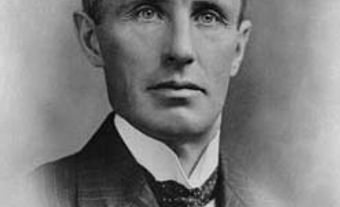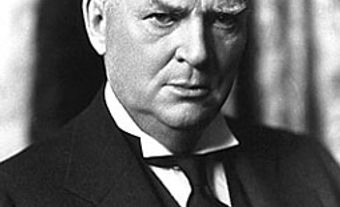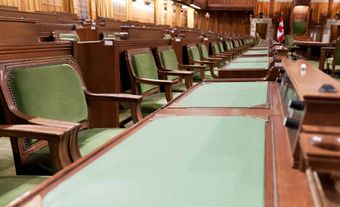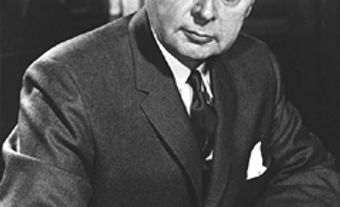John George “Dief the Chief” Diefenbaker, PC, CH, KC, FRSC, prime minister 1957–63, politician, lawyer (born 18 September 1895 in Neustadt, ON; died 16 August 1979 in Ottawa, ON). John Diefenbaker was Canada’s 13th prime minister. He was well known as a defence lawyer before his election to Parliament, and was an eloquent spokesman for “non-establishment” Canada. A supporter of civil rights for all, Diefenbaker championed the Canadian Bill of Rights and the extension of the right to vote to First Nations peoples. He also played an important role in the anti-apartheid statement that led to South Africa’s departure from the Commonwealth in 1961. He was a charismatic and popular speaker; but he was also a divisive force within the Progressive Conservative Party. He was criticized for his indecision concerning nuclear missiles on Canadian soil; for his strained relations with US President John F. Kennedy; and for his cancellation of the Avro Arrow project.

Education and Early Career
In 1903, Diefenbaker and his family moved to the Fort Carlton region of what is now Saskatchewan. He attended schools in several Prairie communities before his family moved to Saskatoon in 1910. He attended the University of Saskatchewan. After serving in the army during the First World War, he completed his law degree and articles. He was called to the Saskatchewan Bar in 1919. His first law office was in Wakaw, Saskatchewan. He moved to the larger northern centre of Prince Albert in 1924.
A Growing Reputation
Diefenbaker’s path to the prime minister’s office was long. He ran federally for Prince Albert in 1925 and 1926; provincially in 1929 and 1938; and for mayor of Prince Albert in 1933. He lost each time. He built a growing reputation as an able defence lawyer and was named King's Counsel in 1929. But he held firmly to the belief that his future lay in politics. In 1936, he became leader of the Saskatchewan Conservative Party, only to preside over the party's defeat in the 1938 election when they won no seats. He continued to preach his own brand of Conservative politics. He visited many Saskatchewan communities with his wife, Edna Mae Brower. He built the party’s organization and encouraged his colleagues to “keep the faith.”
Federal Politics
In June 1939, Diefenbaker was nominated for the federal riding of Lake Centre. In March 1940, he was elected as a Conservative Member of Parliament. The skills he had refined during his legal career served him well on the Opposition backbenches. He gained a wide reputation as an astute questioner of government actions. He was re-elected for Lake Centre in 1945 and 1949. However, he suffered a great personal loss in 1951 when his wife died of acute leukemia.
Not long before his wife’s death, Diefenbaker was approached by the father of Jack Atherton; a railway telegrapher accused of causing a crash at Canoe River, British Columbia. In 1950, two trains had collided head-on. Four locomotive crew members and 17 soldiers bound for Korea were killed. Upon his sick wife’s urging, Diefenbaker agreed to represent the defendant, who had grown up in his riding. In R. v. Atherton (known as the Canoe River case), Diefenbaker successfully defended Atherton, who was found not guilty of manslaughter. The case was followed nationwide and the acquittal celebrated in the press. In Rogue Tory: The Life and Legend of John G. Diefenbaker, biographer Denis Smith referred to the case as “one of his major political assets.”
Diefenbaker was nominated as the Progressive Conservative candidate for Prince Albert in the 1953 election. His campaign and its slogan — “Not a partisan cry, but a national need” — captured the imagination of Prince Albert voters. Diefenbaker was elected. That same year, he married Olive Freeman Palmer. She gave up her own highly successful career in the Ontario Department of Education. Olive Diefenbaker was closely associated with her husband’s political career for the rest of her life.

Prime Minister
In 1956, Diefenbaker was chosen to succeed George Drew, who had resigned as leader of the Progressive Conservative Party. The following year, Diefenbaker led his party to an upset victory over the Liberals and Louis Saint-Laurent. They formed a minority government; the first Conservative government since that of R.B. Bennett. Diefenbaker was backed by a cabinet that included Davie Fulton, Donald Fleming, George Hees, G.R. Pearkes, Douglas Harkness, Ellen Fairclough, Léon Balcer and Gordon Churchill. Diefenbaker consolidated his position in March 1958 when the electorate returned his government with a huge majority of 208 seats; the highest number held by a single party in Canada to that time. (See Elections of 1957 and 1958.)
The Diefenbaker Vision
The Diefenbaker era featured the personality and the style of the “man from Prince Albert.” Several things that are now taken for granted were initiated during his administration. Wheat sales to China and agricultural reform revitalized western agriculture.
Diefenbaker’s determination to guarantee civil rights for all led in 1960 to the Canadian Bill of Rights and to extending the federal vote to First Nations peoples in Canada. (Prior to that point, the Indian Act generally required First Nations peoples to give up their treaty rights in order to be “enfranchised.”) Diefenbaker also nominated James Gladstone, a member of the Blood nation in Alberta, to become the first Indigenous member of the Senate. He also appointed Canada’s first female cabinet minister, Ellen Fairclough.
The Diefenbaker government worked under the philosophical umbrella of “social justice.” It restructured programs to provide aid to those in need. In addition to the Agricultural Rehabilitation and Development Act (1961), his government also established a Royal Commission on Health Services (1961); as well as the National Productivity Council (1963) — later named the Economic Council of Canada. The “northern vision” that figured so prominently in the rhetoric of the 1957 and 1958 elections increased public awareness of the Far North. It also led to some economic development in that region.
A tour of the Commonwealth in 1958 reinforced Diefenbaker’s belief in the value of that organization and other international bodies. It also helped to define his role as a supporter of the non-White Commonwealth. Diefenbaker played a key role in the 1961 anti-apartheid statement that contributed to South Africa’s withdrawal from the Commonwealth.
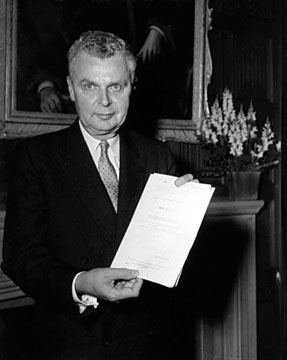
An Indecisive Image
During the 1962 election, the Liberals exploited the economic crisis (the Canadian dollar had dropped to 92.5 cents US); the controversial 1959 cancellation of the Avro Arrow; and the debate over nuclear weapons on Canadian soil, including charges against Diefenbaker of anti-Americanism. ( See Bomarc Missile Crisis.) The Diefenbaker government was reduced to a minority.
In the fall of 1962, Diefenbaker’s popularity was severely hampered by his response to the Cuban missile crisis. His hesitant response to the crisis reflected his desire to preserve the independence of Canada’s foreign policy. The delay, however, was widely criticized in Canada. It led to a growing perception that the Diefenbaker government was indecisive. Diefenbaker’s response worsened already tense relations with the Kennedy administration. It also fuelled controversy and confusion in Canada over the country’s policy on nuclear weapons. In the wake of the crisis, the US accused the Diefenbaker government of lying and avoiding its military duties.
Diefenbaker’s Progressive Conservatives lost to Lester B. Pearson and the Liberal Party in the election on 5 February 1963. Diefenbaker, travelling the country by train, almost won the election in what was possibly the most spectacular one-man political campaign in Canadian history.
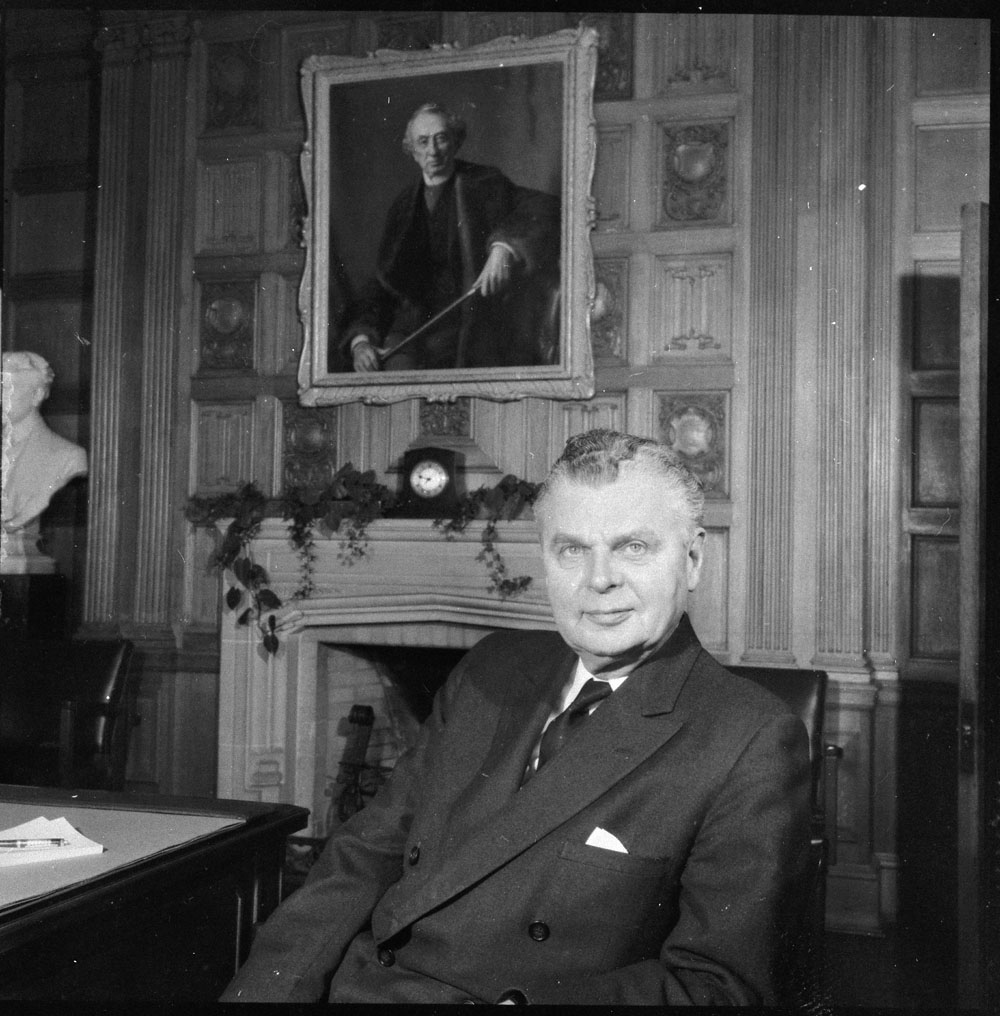
Leader of the Opposition
As leader of the Opposition, Diefenbaker delighted in questioning Prime Minister Lester Pearson’s government to such an extent that the House’s business slowed considerably. He also argued vigorously (if unsuccessfully) against Pearson’s proposal for a new Canadian flag. (See The Great Flag Debate.) Diefenbaker also led the attack on the Liberals during the scandals of 1965. In turn, the Liberals criticized Diefenbaker for his role in the Munsinger Affair.
Late Career and Legacy
Despite the electoral setbacks and a party deeply split over the question of his continuing leadership, Diefenbaker refused to resign. He put up a spirited defence at the 1967 leadership convention, where Robert Stanfield was chosen as the new leader. Diefenbaker remained in politics under Stanfield and later Joe Clark. In May 1979, he won a seat for the 13th time but died only a few months later. Thousands of mourners paid their respects during the elaborate funeral (all planned by Diefenbaker himself); it included a state funeral in Ottawa, a final train journey across Canada, and burial in Saskatoon beside the Right Honourable John G. Diefenbaker Centre at the University of Saskatchewan.
See also Diefenbunker, Canada's Cold War Museum.

 Share on Facebook
Share on Facebook Share on X
Share on X Share by Email
Share by Email Share on Google Classroom
Share on Google Classroom

